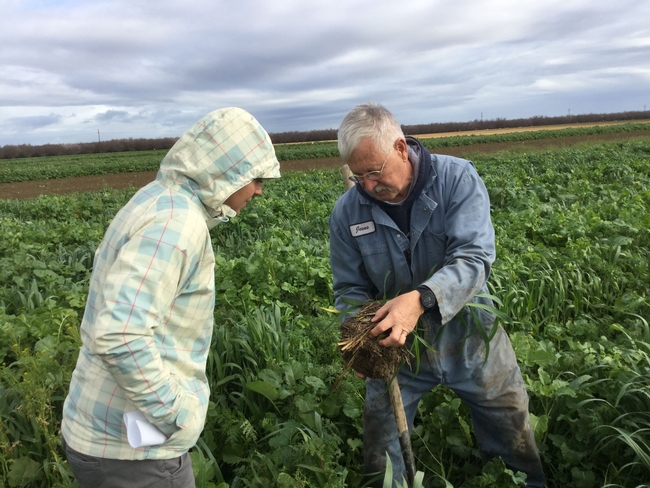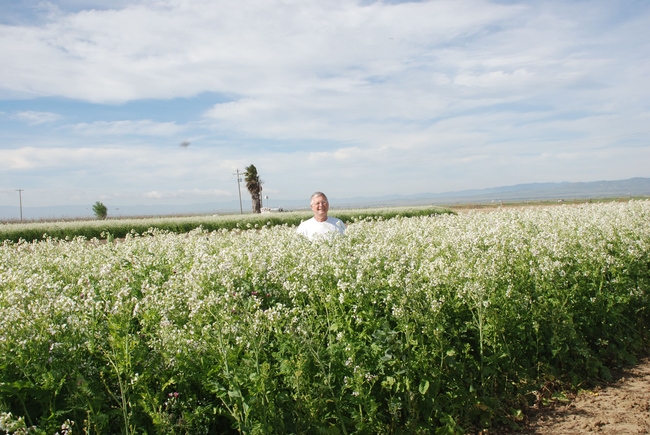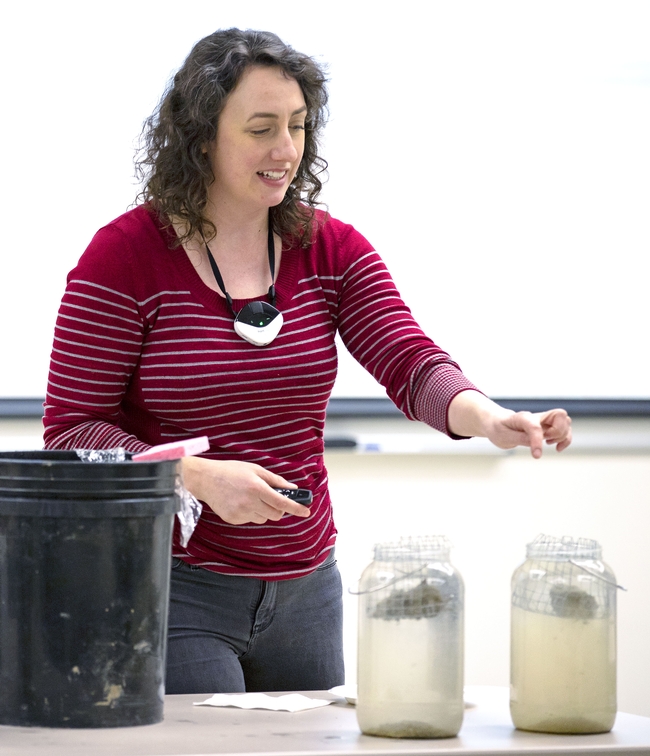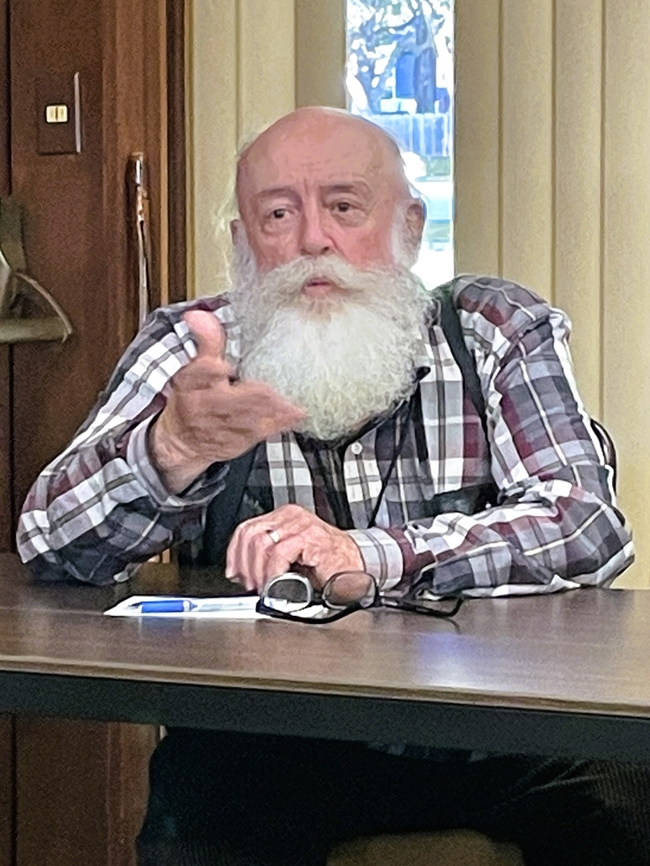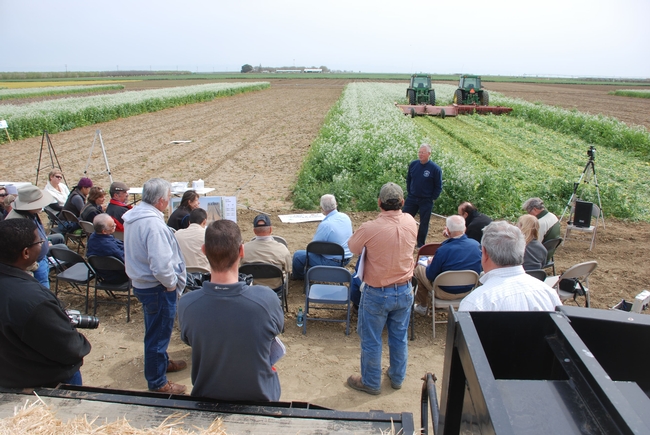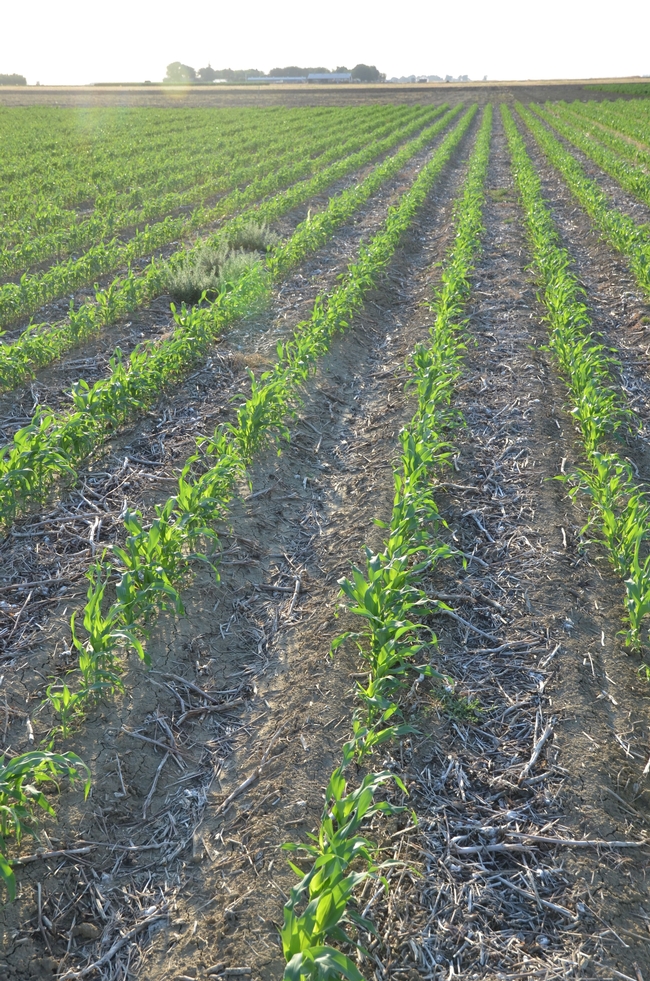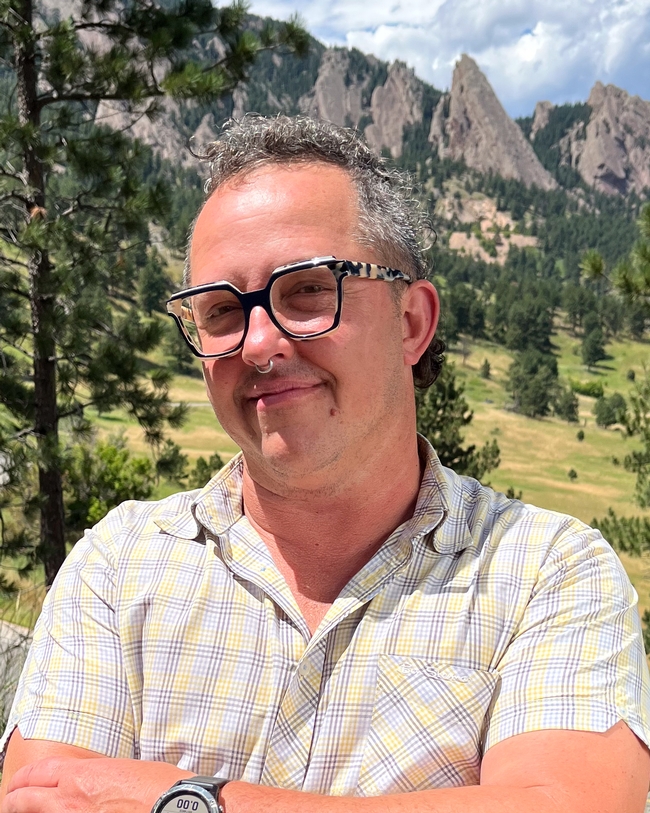Posts Tagged: Sarah
Lawn-pocalypse! Surviving Drought
Ah, summer! The season of sunburns, pool parties, and… lawn droughts. If your once lush, green carpet now looks like a crunchy brown doormat, you're not alone. Let's dive into why your yard is staging a dramatic death scene and what you can do to...

Bermuda grass and weeds overtaking drought stressed turf grass.
West Side REC study: A cradle of California regenerative agriculture
In 20-year study, UCCE specialist Mitchell, colleagues, growers advance no-till and cover cropping practices
In the 1990s, long before “regenerative agriculture” was a buzzword and “soil health” became a cause célèbre, a young graduate student named Jeff Mitchell first learned about similar concepts during an agronomy meeting in the Deep South.
Mitchell was astonished to hear a long list of benefits attributed to practices known internationally as “conservation agriculture” – eliminating or reducing tillage, cover cropping and preserving surface residues (the plant debris left after harvest). Potential positive impacts include decreasing dust in the air, saving farmers money on fuel and equipment maintenance, improving soil vitality and water dynamics and a host of other ecosystem services.
“All of these things start adding up and you kind of scratch your head and say, ‘Well, maybe we ought to try some of this,'” recalled Mitchell, who became a University of California Cooperative Extension cropping systems specialist at UC Davis in 1994.
In 1998, Mitchell launched a long-term study of those practices at the West Side Research and Extension Center (REC) in Five Points, Fresno County. “We started this because, way back when I first began my job, nobody was doing this,” he explained. “This was brand-new, uncharted territory for California.”
For the next 20 years, Mitchell and his colleagues studied changes to the soil and ecosystem, learned from their failures and successes, and shared those hard-won lessons with fellow scientists and farmers across the state. A summary of their findings was recently published in the journal California Agriculture.
Conservation agriculture in California: ‘No trivial undertaking'
Mitchell and the Conservation Agriculture Systems Innovation Workgroup – a network established in 1998 comprising farmers, researchers, public agency personnel and members of private entities and environmental groups – started with a virtually blank slate. According to Mitchell, surveys at the beginning of the 21st century found that conservation agriculture practices were used on less than one-half of 1% of annual crop acreage in California.
Although no-till is common in the Midwest and Southeast of the U.S. and across wide swaths of the globe, it was almost unheard of in the Golden State. With the development of irrigation infrastructure in the 1920s, California farmers saw continually phenomenal growth in yield over the last century – and thus had little incentive to deviate from tried-and-true methods that relied on regular tillage.
Nevertheless, intrigued by the potential benefits of conservation agriculture, Mitchell wanted to see which of those practices could be feasibly applied to California cropping systems. During the 20-year study at West Side REC, the researchers grew a rotation of cotton-tomato, followed by a rotation of garbanzo, melons, and sorghum, and finally tomatoes.
But at first, it was a struggle to grow anything at all – as they had to master the basics of how to establish the plants in a no-till, high-residue system.
“This was no trivial undertaking,” Mitchell said. “Early on we struggled – we failed the first couple of years because we didn't know the planting techniques and we had to learn those. There was an upfront, very steep learning curve that we had to manage and overcome.”
Then there was the long wait to see any measurable improvements to soil health indicators, such as the amount carbon in the soil.
“For the first eight years, we didn't see any changes whatsoever,” Mitchell said. “But then they became strikingly different, between the no-till cover crop system and the conventional field without cover crops, and the divergence between those two systems became even starker.”
The two-decade time horizon for the West Side REC study is one major reason why it has been so valuable for growers and scientists alike.
“It's so hard to capture measurable changes in soil health and soil function metrics through research because those changes are really slow,” said Sarah Light, UCCE agronomy farm advisor for Sutter, Yuba and Colusa counties and a co-author of the recent California Agriculture paper. “Often in the course of a three-year grant you don't actually get statistically significant differences.”
Reaching, teaching and learning from farmers
The study site on the west side of the San Joaquin Valley also has been a vital teaching resource. Even though Light works with farmers in the Sacramento Valley, she has conveyed findings from that research with her clientele and uses soil samples from the site to vividly illustrate a significant benefit of conservation agriculture practices.
In one demonstration, she drops soil aggregates – which look like clumps of soil – into two containers of water. One clump, from heavily tilled land, falls apart quickly and the water becomes dark and murky. The other, comprised of soil that has been no-till and cover cropped for 20 years, holds together – a sign of healthy, resilient soil – and the water remains relatively clear.
“It's a really simple demo, but it's very effective because it shows how easily soil aggregates break apart with water – or not,” Light said.
That aggregate stability is a key factor in soil's ability to both move water (infiltration) and hold onto water (retention). Those dynamics are crucial for farmers to avoid ponding in their fields, preserve water for drier months, and generally endure the flood/drought whiplash of climate change.
Over the years, Mitchell has hosted thousands of visitors at the West Side REC study site to showcase the potential benefits of adopting soil-health management practices.
“I don't think I'm exaggerating in saying that this is probably the most-visited agricultural field station project in the history of UC ANR (UC Agriculture and Natural Resources),” he said.
Both the West Side REC – and Mitchell himself – are greatly valued by the local grower community.
“Jeff is a microcosm of the university's applied research on the West Side of the San Joaquin Valley,” said John Diener, who grows almonds, fresh market garlic, canning tomatoes, cotton, masa corn and wheat for production and seed on land adjacent to the field station.
Growers adopt, adapt and adjust practices
Tom Willey, a retired farmer and longtime collaborator with Mitchell, has actively encouraged peers to visit the Five Points site – especially in the early years.
“It was very innovative and there weren't many examples of that anywhere in the state,” Willey said. “So, I helped encourage people to go out there and learn and possibly think about doing similar work on their own farms.”
Willey himself was a pioneer in experimenting with no-till practices in organic vegetable cropping systems.
“As organic farmers, we were probably more tillage dependent than conventional farmers because it was the only method we had for weed control; we weren't able to use herbicides,” Willey said.
Despite early struggles, he persisted in trying different techniques and mechanical means of weeding. And Willey later partnered with a group of progressive vegetable growers and UC and California State University Chico personnel to secure a Conservation Innovation Grant from the Natural Resources Conservation Service to support more on-farm trials and share their experiences.
In the end, however, no-till proved too risky to continue, given the losses they incurred. One tricky issue is nutrient cycling. The organic growers found that after mowing down a cover crop and spreading compost, leaving those nutrients on the surface without incorporating into the soil through more vigorous tilling (or adding synthetic fertilizers, as conventional growers could do) results in lower yields. In the short term, farmers simply did not see yields that could sustain their operation.
“It's very difficult in vegetable systems, and particularly difficult in organic vegetable systems,” Willey said. “I would say a number of us have learned to diminish the over-reliance that we had on tillage, but not to completely eliminate it.”
Cover cropping is also a challenge for some farmers, with certain cover crops making a perfect haven for devastating pests such as lygus bugs and stink bugs, according to Diener.
“We do everything we can to eliminate the host crop from which they come, so why am I going to bring the enemies to my house?” he said. “It's about making enough money to be there next year. You're not going to be there next year with these pests. It's just not a practical management option, in light of our significant pest pressure and disease hosts for our crops of value.”
Instead of planting cover crops, Diener said he opts for mixing in grain crops that can similarly contribute to soil health – while generating revenue at the same time. According to Diener, a longtime collaborator with Mitchell, the best way to adopt conservation agriculture practices is to tailor them to specific localities and each grower's circumstances. And in his corner of the San Joaquin Valley, that means not following the template of the high-precipitation, no-till systems found in the Midwest.
“We've adapted Jeff's principles to our program; it won't look like Iowa to you, which is what everybody comes to expect to see. It ain't how it works, folks,” Diener said. “It's a different methodology. We do those things that fit our environment and that's why that West Side field station is important – because it's our environment.”
Promoting and enhancing soil health, one step at a time
More widespread adoption of soil-health management practices can be driven by a variety of factors. With the rise of drip irrigation in tomatoes, for example, more growers began using no-till or reduced till to minimize disruptions to the delicate driptape in their fields.
And, according to Mitchell, the dramatic increase in no-till practices in dairy silage production – from less than 1% to over 40% – was the result of entrepreneurial efforts by a small but extraordinarily dedicated group from the private sector that worked with farmers, one by one.
Because optimizing these practices requires close and intensive attention – and no small amount of courage and gumption – Mitchell and Light understand that growers might need to take an incremental approach. Even one fewer pass over the field, or cover cropping every other year, can provide some benefit for soil health, Light said.
“The value is that when you can prove the concept, then you can motivate every step of the way,” Light explained. “Jeff is showing the shining light of the goalposts, and that can motivate us to take every challenging step along the way.”
Shannon Cappellazzi, who helped with the data analysis on the recently published California Agriculture paper, agrees that there is value in taking a stepwise approach in building soil health.
Cappellazzi was the lead project scientist on the Soil Health Institute's North American Project to Evaluate Soil Health Measurements, which looked at 124 different long-term soil research sites across the continent – including the Five Points site.
After analyzing 2,000 samples from the various study sites, Cappellazzi said the evidence suggests that layering on each component of a conservation agriculture program – doing no-till, adding cover crops and then integrating livestock, for example – can have additive, cumulative benefits for soil health.
“I think having the data to show the long-term benefit makes people willing to do the short-term change, even if it's a little bit hard for a couple years,” Cappellazzi said.
The research at the West Side REC also produced another key takeaway.
“To me, what really stood out was that for most of the soil health indicators, cover crops had a huge impact. Both the cover crops that had no till – and the cover crops that had standard tillage – had considerably higher carbon and soil health indicator measurements than those without cover crops,” said Cappellazzi. She added that the data also indicated improvements in how the water moved into the soil, and how the soil held that water.
Vital research drives an enduring legacy
Water management and conservation, of course, will be paramount in California's increasingly volatile climate reality. Mitchell's Five Points research – and related studies across the San Joaquin Valley by UC Davis agroecologist Amélie Gaudin and others – contributed data that overturned a long-held belief about winter cover cropping.
“There's a lot of preconceived ideas about cover crop water use,” Mitchell said. “One of the things that we learned was that compared to bare soil water loss in the wintertime, cover crop water loss during that same growing period – from about November through March – tends to be almost a wash.”
That crucial finding provided researchers and soil health advocates with invaluable evidence to preserve the practice as an option for farmers.
“They've needed to go around and give a dog-and-pony show to a lot of Groundwater Sustainability Agencies (GSA) that had been on the brink of banning the growing of cover crops because the perception out there is that they use a lot of water,” said Willey, the retired vegetable grower. “But over the winter months, cover crops don't use a lot of water. In fact, they may not use any net water at all.”
The young researchers who studied cover-crop water use represent another important legacy of the Five Points study site. It has been an experiential training ground for many of the next generation of soil scientists, agronomists and ecologists.
“The number of students who have been trained by and through this study has been really phenomenal,” said Mitchell, noting that they have worked on topics ranging from air quality to soil carbon related to no-till and cover cropping.
Their contributions will be essential in continuing to refine and optimize these practices that are fundamental to conservation agriculture. On Diener's concerns about lygus bugs and stink bugs, for example, Cappellazzi – in her new role as director of research at GO Seed – is studying and breeding cover crops with an eye on characteristics that make for less hospitable habitats for certain pests.
Indeed, while the California Agriculture paper effectively wraps up the 20-year study at Five Points, its lessons will continue to resonate and inspire for years to come.
“This is a step in a long journey,” Light said. “It's a launchpad – this paper might be able to tie a bow on it in terms of the data collection, but in terms of the extension impact, this is really just the beginning.”
And for Willey, the omnipresent climate crisis compels the entire sector to pick up the pace along that journey.
“We've got a lot of pressure now to evolve agriculture very rapidly in response to climate change and I don't think we can sit around and twiddle our thumbs,” he said. “We know the directions we need to be heading – with more natural systems mimicry and less reliance on toxic inputs and synthetic fertilizers – and we need to figure out how to incentivize and support farmers in moving in those directions.”
UC ANR adds 9 experts in water, wildfire, pest management and more
To help more Californians address challenging issues, University of California Agriculture and Natural Resources has hired UC Cooperative Extension experts to work in communities stretching from Humboldt and Siskiyou counties in the north, and south to San Diego County. State funding has enabled UC ANR to expand its expertise.
Since 1914, UC Cooperative Extension's researchers have been working directly with community members to improve the lives and livelihoods of Californians.
The nine recently hired UC Cooperative Extension specialists and advisors bring expertise in forestry, pest management, water, plant disease, horticulture, toxicology, economics, rice farming and wildfire.
To see a list of UC Cooperative Extension advisors who have joined in the past few months, visit https://ucanr.edu/About/DirectorySearch/Recent_Hires. The most recently hired scientists are introduced below.
Gill joins UCCE as environmental horticulture advisor
Haramrit Gill joined UC Cooperative Extension on April 1 as an environmental horticulture advisor for Tulare, Kings, Fresno and Madera counties.
She will be identifying landscape plants that are heat-tolerant, disease-resistant and fire-resistant. Gill will be researching California native plants with sustainable attributes that include superior adaptation, biodiversity enhancement, water efficiency and soil health benefits.
A native of Punjab, India, Gill earned her undergraduate degree in agriculture followed by a master's degree in horticulture at Punjab Agricultural University, where her research focused on micropropagation and haploid production in muskmelons. She earned a Ph.D. from the Department of Horticultural Sciences at Texas A&M University.
Her early research investigated the impact of nitrogen on spinach root architecture. Her doctoral work concentrated on rose breeding and deciphering the genetic underpinnings of flower color transition traits, fragrance and dwarfing in roses, with a particular focus on the intriguing phenomenon of flower color transformation from yellow to dark pink as blooms matured. She also collaborated on projects aimed at enhancing heat tolerance and disease resistance in roses.
Gill is based at the UCCE office in Tulare and can be reached at hamgill@ucanr.edu.
Jordan joins UCCE as forestry and natural resources advisor
Christian Jordan joined UCCE on March 18 as a forestry and natural resources advisor for Shasta, Siskiyou and Trinity counties. He will work to advance forest resilience and sustainable management on private and public lands, with a focus on conifer forest resource management and sustainable natural resources.
In 2020, Jordan completed a Master of Forestry at UC Berkeley, with an emphasis on forest resilience in the context of increasingly severe wildfires. Prior to joining UC ANR, he worked in the private sector in defensible space and home hardening, installing residential exterior sprinkler systems for ember defense.
Jordan brings a diverse educational and work background to the position. In 2014, he earned a bachelor's degree in geography from UC Berkeley, writing a thesis on future climate and viticulture in Napa and Sonoma counties. Upon graduating, he worked in the wine industry before returning to natural resources.
Jordan is based at the UCCE office in Redding and can be reached at cjordan@ucanr.edu.
Pastrana joins UCCE as plant pathology advisor
Ana Pastrana joined UCCE on Jan. 16 as a plant pathology advisor serving Imperial, Riverside and San Diego counties.
In her role, Pastrana will collaborate with pest control advisers and support growers with disease management. In addition to identifying high priority concerns, she will conduct research and develop educational content that addresses growers needs.
Before moving to Southern California, Pastrana worked as a research scientist on plant pathology at the University of Seville, Spain, and at Vineland Research and Innovation Center in Canada. Previously, she completed a postdoctoral assignment in the Department of Plant Pathology at UC Davis in the Thomas Gordon Lab, where she specialized in soilborne diseases affecting strawberries and blackberries.
While attending the University of Seville, Pastrana earned master's and bachelor's degrees in biology. At Investigación y Formación Agraria, Pesquera, Alimentaria y de la Producción Ecológica, a government institution in Spain, she earned a Ph.D. and completed her dissertation on strawberry diseases.
“At that time, Europe banned methyl bromide and other soil disinfectants. Strawberries rely on these disinfectants so plenty of soilborne diseases emerged,” Pastrana said.
Originally from Seville, Spain, Pastrana said that her small hometown is surrounded by plum and citrus trees. Her mother, like many others, worked in the agricultural industry and Pastrana wondered how plant life works, inspiring her to study biology.
As a Ph.D. student, Pastrana didn't know she would pursue plant pathology specifically because she was open to studying diseases in general whether it be humans, animals or plants.
“Plant pathologists are like doctors. Not everyone is happy to work with us because it usually means that there is some sickness involved,” said Pastrana. “But if growers work with pathologists from the beginning, we can focus on preventative care and helping to protect plants from getting sick.”
Pastrana is based at the UCCE office in Holtville and can be reached at ampastranaleon@ucanr.edu.
Mokwunye named area IPM entomology advisor
Idongesit Mokwunye joined UCCE on Jan. 3 as an area integrated pest management entomology advisor.
She will be studying insect pests of economic importance affecting tree fruit and nut crops, such as pistachio, almond, walnut, table grapes and stone fruit. Major pests include navel orangeworm, mealybug, carpophilus beetle, mites and scale insects.
Prior to joining UC ANR, Mokwunye worked as a nut crop entomologist at the Cocoa Research Institute of Nigeria for over 15 years and headed its Crop Protection Division.
“My journey into entomology as a career started when I was posted to the Cocoa Research Institute of Nigeria for the mandatory one-year National Youth Service Corp,” Mokwunye said.
“I was really fascinated at the diversity and economic importance of the insect species (both beneficial and pests) on agricultural crops and natural landscapes generally,” she said. “The hands-on lab experiments and field activities were exciting, engaging and inspiring. I was actively involved in setting up experiments, data collection, data entry and informal discussions on research projects. I was seeing the insect world in an entirely different perspective.”
She already held a bachelor's degree in zoology from the University of Lagos, Nigeria.
“The then-head of the department observed my interest and encouraged me to get a master's degree,” said Mokwunye, who then earned a master's degree in entomology from the University of Ibadan, Nigeria. “During the course of the second degree, I got a job in the same institute and today the rest is history.”
Mokwunye holds a Ph.D. in entomology from the Federal University of Agriculture Abeokuta, Nigeria. Her research interests include integrated pest management, chemical ecology, extension entomology and economic entomology. She has worked on the population dynamics of the cashew stem girdler as it correlates with weather parameters, its damage potential, semiochemical interactions and chemical control of insect pests.
She has served as a resource person engaging stakeholders in outreach activities and facilitating training programs on good agricultural practices. In addition to publishing more than 25 research articles, she is a fellow of African Women in Agricultural Research and Development, Orange Knowledge Program of the Netherlands Government, and Scientific Exchanges Program of the USDA.
“I am delighted to be here as a UC Cooperative Extension advisor and I hope to bring my expertise and experience in pest management to bear,” she said. “I plan to connect and engage meaningfully with my clientele in order to understand their needs, priorities and perspectives regarding pest management issues.”
Mokwunye is based at Kearney Research and Extension Center and can be reached at (559) 807-0257 and imokwunye@ucanr.edu.
UCCE water advisor Garza hopes to foster ‘spirit of shared responsibility'
Laura Elisa Garza Díaz joined UC ANR on Jan. 3 as the UC Cooperative Extension water quality, quantity and climate change advisor for Lake and Mendocino counties, focusing on how intensified droughts, floods, wildfires and other climate impacts affect water supply and quality.
She aims to address Sustainable Groundwater Management Act requirements and enhance local water resilience in collaboration with farmers and natural resource managers, local government water agencies, water districts and other key stakeholders.
In addition to guiding policymakers in creating comprehensive water-resiliency plans covering development, storage, alternative sources and conservation, Garza – who is fluent in Spanish – will share water research with a diverse range of communities.
“I aim to empower local stakeholders by providing them with the knowledge and tools needed to navigate the complex landscape of water quality, quantity and climate change,” she explained. “My goal is to foster a spirit of shared water responsibility, and ensure that water management practices consider the needs of all – for a more just and inclusive environment for everyone.”
Originally from Monterrey, Mexico (“the city of the mountains,” as she puts it), Garza earned her bachelor's degree from Tecnológico de Monterrey. After completing an Erasmus Mundus joint master's degree program in applied ecology, Garza worked as a specialist with the Water Center for Latin America and the Caribbean.
While pursuing her Ph.D. at UC Davis, she served as a scientific advisor for Pronatura Noroeste, an environmental protection organization, and started the Women in Science Interview Sessions at the Permanent Forum of Binational Waters, where she volunteered. It is an initiative to interview women who have worked or researched water topics in the Rio Grande/Rio Bravo Basin.
After obtaining her Ph.D. in hydrologic sciences from UC Davis, Garza worked as a project manager for the Washington Water Trust in Washington.
At every step of her journey, Garza has been motivated by a deep passion for safeguarding water resources and fostering resilient ecosystems and communities.
“I find inspiration in the intersection of science, community engagement and sustainable water management,” she said. “The opportunity to contribute to the well-being of local communities and the environment drives my commitment to addressing water challenges in a changing climate.”
Based at the UCCE office in Ukiah, Garza can be reached at legarza@ucanr.edu and (707) 463-4495.
Agyeman joins UCCE as economics advisor for Butte, Glenn and Tehama counties
Domena Agyeman joined UCCE Jan. 3 as an agriculture and natural resources economics advisor for Butte, Glenn and Tehama counties.
Prior to joining UC ANR, he was a postdoctoral associate at the Virginia Seafood Agricultural Research and Extension Center at Virginia Tech University.
As a UCCE advisor, Agyeman will provide insights that ensure economic profitability of all agriculture activities, including orchards, rice, forestry and other natural resources-based businesses in those counties. He will also promote broadband access and contribute to regional economic development.
“I am excited to leverage my expertise to highlight the economic contributions and impacts of the agriculture and natural resources industries in Butte, Glenn and Tehama counties,” Agyeman said, “and to provide producers and other stakeholders in the region with research-based information that will help them navigate their business challenges and opportunities.”
His research interests encompass natural resources and environmental policy impact assessments, economic contributions and impacts analyses, producer decision-making assessments, and consumer preferences assessments.
“To get started, I will be doing a needs assessment, focus group meetings and surveys of target groups,” he said.
Agyeman earned a Ph.D. in agricultural economics from the University of Kentucky, a master's degree in agricultural economics from Mississippi State University and bachelor's degree in agricultural science from University of Cape Coast in Ghana.
Agyeman is based at the UCCE office in Oroville and can be reached at dagyeman@ucanr.edu.
Marsh named rice advisor for Colusa and Yolo counties
Sarah Marsh joined UCCE on Jan. 3 as a rice farming systems advisor serving Colusa and Yolo counties.
Prior to joining UCCE, she worked in rice breeding research and integrative pest management with several row crops in the Upper Gulf Coast region.
She earned a master's degree in horticulture and agronomy at UC Davis, where she worked with Kassim Al-Khatib, professor of plant sciences, studying weeds and herbicide resistance in rice agroecosystems. She holds a bachelor's degree in plant and environmental soil science from Texas A&M University.
“I grew up on a diversified row-crop and orchard farm in Arbuckle and am grateful for the opportunity to serve the community in which I was raised,” Marsh said. “I hope to spend the first few months getting to know the growers and community of this region and learning what the unique needs of our area are.”
Marsh is based at the UCCE office in Colusa and can be reached at smarsh@ucanr.edu and (530) 415-7052.
Woelfle-Hazard joins UCCE Humboldt-Del Norte as fire advisor
Cleo Woelfle-Hazard joined UCCE on Jan. 3 as a fire advisor for Humboldt and Del Norte counties. He will support residents, landowners, planners, land managers, tribes and Native fire practitioners in making North Coast communities more resilient in the face of intensifying wildfires.
His research and extension programs focus on climate resilience, cultural burning, fire-water interactions and training a diverse fire workforce.
Woelfle-Hazard collaborates on research with Native nations, agencies and local community members. In collaboration with the Karuk Department of Natural Resources, he is exploring future fire scenarios in the Klamath Basin and how streamflow would change. They are also exploring how fire and flooding can be renewed to revitalize habitat for ecocultural species such as willow, grape, salmon, elk and eel.
His past projects have included community-directed river research with frontline communities in Seattle, the Yukon-Kuskokwim Delta and Sonoma County. Using his expertise in home water and wastewater systems, he evaluated health and economic aspects of water delivery in Oakland and Hubli-Dharwad, India.
As a co-investigator on the Humanities Education for Anti-Racism Literacy project, Woelfle-Hazard collaborated on creating pathways to higher education for Native youth, and for training students to engage in respectful collaborations with Native partners.
He earned a master's degree and Ph.D. in energy and resources at UC Berkeley, where he convened scientists and Sonoma County residents to experiment with capturing winter rain to increase summer streamflow to benefit juvenile salmon, and exploring the possibilities of working with beavers to create cool refuges for coho. He also holds a bachelor's degree in interdisciplinary geosciences from the University of Montana.
Woelfle-Hazard is based in Eureka and can be reached at cwhaz@ucanr.edu.
Jegede joins UCCE as agricultural toxicology specialist
Olukayode “Kayode” Jegede joined UC ANR on Jan. 2 as an assistant professor of Cooperative Extension for agricultural toxicology with the Department of Molecular Biosciences, School of Veterinary Medicine and Department of Environmental Toxicology in the College of Agricultural and Environmental Sciences at UC Davis.
Jegede will be studying contaminants of agricultural importance in California, such as pesticides, metals, microplastics, veterinary pharmaceuticals, PFAS, fertilizers and their effects on humans, animals (including aquaculture) and environmental health of soil and plants.
“I will also be looking at various exposure pathways of these contaminants and interactions through food, water, soil and how climate change or other major environmental change events can influence toxicity of these contaminants and mitigation strategies,” Jegede said. “My research will also have a “one-health” perspective to it.”
Prior to moving to California, Jegede was a postdoctoral research associate at the Department of Soil Science, University of Saskatchewan, Canada for a year before moving to Wageningen University and Research in the Netherlands to work as a research scientist focused on terrestrial ecotoxicology.
His past research has examined the effects of metals, pesticides and mixture toxicity on soil biota (mites, springtails, snails, earthworms) and soil enzymes, related ecosystem service function and generating data for environmental risk assessment of metals and pesticides.
“I look forward to helping solve toxicology issues in California through research, advising on and promoting good health for everyone and everything connected to small and large-scale agriculture in California.” Jegede said.
He earned his Ph.D. in toxicology at the University of Saskatchewan in Canada and bachelor's and master's degree in zoology at the Obafemi Awolowo University in Nigeria.
Jegede is based at UC Davis and can be reached at ojegede@ucdavis.edu.
Meet our New Rice Farming Systems Advisor, Sarah Marsh
My name is Sarah Marsh, and I am excited to join UC Cooperative Extension as the new Rice Farming Systems Advisor serving Colusa and Yolo counties. I will be based out of Colusa at the Colusa UCCE office. I grew up on a diversified row-crop and orchard...
Tips on How to Write a Research Paper or Term Paper
If you're a student in a UC Davis Department of Entomology and Nematology class taught by UC Davis Distinguished Professor James R. Carey, you'll learn from the pro how to write a research paper or term paper, a requirement in his...
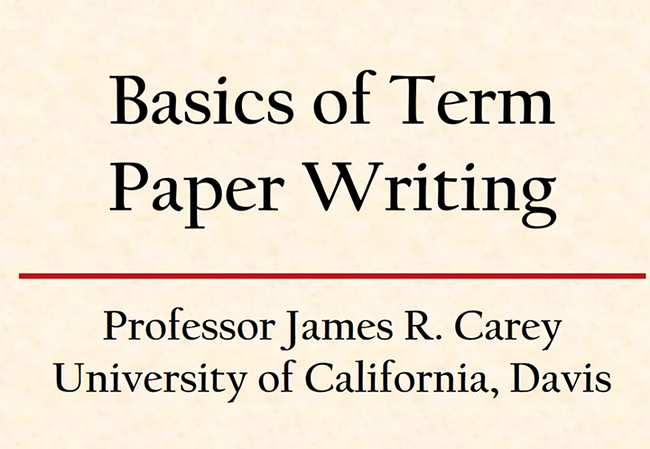
Screen shot from UC Davis Distinguished Professor James R. Carey's teachings.

